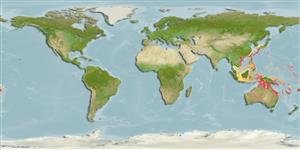Common names from other countries
>
Eupercaria/misc (Various families in series Eupercaria) >
Labridae (Wrasses) > Bodianinae
Etymology: Choerodon: Greek, choiros = a pig + odous = teeth (Ref. 45335); referrring to the prominent anterior canines of the species in this genus (Ref. 116605).
More on author: Günther.
Environment: milieu / climate zone / depth range / distribution range
Ekologi
laut berasosiasi dengan karang; kisaran kedalaman 5 - 35 m (Ref. 9823), usually 5 - 35 m (Ref. 27115). Subtropical; 25°C - 28°C (Ref. 27115)
Western Pacific: disjunct distribution, Ryukyus to Taiwan, then from New Caledonia to Queensland, Australia.
Size / Weight / umur
Maturity: Lm ? range ? - ? cm
Max length : 30.0 cm TL jantan/; (Ref. 2334)
Duri punggung (Keseluruhan (total)) : 12; duri punggung lunak (Keseluruhan (total)) : 8; Duri dubur: 3; Sirip dubur lunak: 10. Body with 7 or 8 pairs of alternating prominent red, blue, white and blackish bands. Pectoral fins with ii unbranched and 14 branched rays. Predorsal scales approximately 10 to 14, reaching forward in advance of posterior extent of orbit on dorsal midline of head. (Ref 9823)
Adults inhabit seaward reefs (Ref. 9710). Feed on mollusks, crustaceans, various worms, and echinoderms. Solitary and territorial species (Ref. 9710). Monogamous (Ref. 52884). Oviparous, distinct pairing during breeding (Ref. 205). Maximum depth reported from Ref. 27115.
Life cycle and mating behavior
Maturities | Reproduksi, perkembang biakan | Spawnings | Egg(s) | Fecundities | Larva
Oviparous, distinct pairing during breeding (Ref. 205).
Randall, J.E., G.R. Allen and R.C. Steene, 1990. Fishes of the Great Barrier Reef and Coral Sea. University of Hawaii Press, Honolulu, Hawaii. 506 p. (Ref. 2334)
Status IUCN Red List (Ref. 130435)
CITES (Ref. 128078)
Not Evaluated
ancaman kepada manusia
Harmless
penggunaan manusia
Perikanan: komersial; Akuarium: Komersial
Alat, peralatan
laporan khas
muat turun XML
Sumber internet
Estimates based on models
Preferred temperature (Ref.
115969): 24.5 - 28.7, mean 27.4 (based on 486 cells).
Phylogenetic diversity index (Ref.
82804): PD
50 = 0.5000 [Uniqueness, from 0.5 = low to 2.0 = high].
Bayesian length-weight: a=0.01318 (0.00582 - 0.02984), b=3.05 (2.86 - 3.24), in cm Total Length, based on LWR estimates for this (Sub)family-body shape (Ref.
93245).
Trophic level (Ref.
69278): 3.4 ±0.40 se; based on food items.
Daya lenting (Ref.
120179): sedang, Waktu penggandaan populasi minimum 1.4 - 4.4 tahun (Preliminary K or Fecundity.).
Fishing Vulnerability (Ref.
59153): Low vulnerability (20 of 100).
